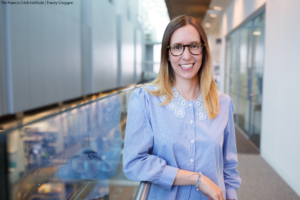Biography
I have studied Biology at the University of Milan in Italy. During my university studies, I realized that developmental biology is my passion. I did my Ph.D. at the Max Planck Institute for Heart and Lung Research. I joined the lab of Prof. Stainier, where I studied vascular biology in zebrafish embryos, and I learned about embryogenesis, tissue interactions, and live imaging.
I was awarded the Otto Hahn Medal from the Max Planck Society. It was a great honor! Then, I decided to make a change in my career and learn about mammalian embryogenesis. That is why I joined the lab of Dr. Niakan at the Francis Crick Institute in London. This helped me to develop further my embryology skills and expand my network. Moreover, I became deeply interested in placenta development. During my postdoc, I had the great opportunity to develop my own collaborations. I was a visiting scientist at the Royal Veterinary College, where I learned about bovine embryos. Also, I had the amazing experience to work in a fertility clinic in Brussels. Towards the end of my postdoc, I decided to take the time to expand my knowledge in 3D models and I have started working on placenta organoids.
I have applied to the free-floater Max Planck Society group leader position, which I was very honored to receive. This gave me the opportunity to visit various Institutes to decide which one to choose to start my lab. I have decided to join the Max Planck Institute of Molecular Cell Biology and Genetics in Dresden.
Education and positions held
- 2022 – present:
- Group Leader at the Max Planck Institute of Molecular Cell Biology and Genetics, Dresden, Germany
- 2017-2021:
- Postdoctoral Training fellow at The Francis Crick Institute, London, United Kingdom
- 2018-2020:
- Visiting Scientist at the Royal Veterinary College, London, United Kingdom
- 2019:
- Visiting Scientist at the Centre of Reproductive Medicine – UZ Brussels, Belgium
- 2012-2017:
- Ph.D. in Developmental Genetics at the Max Planck for Heart and Lung Research and Goethe University Frankfurt, Germany
- 2010-2012:
- MSc internship in Molecular Biology of Cell at the University of Milan and University of Brescia, Italy
- 2007-2010:
- BSc in Biological Sciences at the University of Milan
Research Summary
In the Gerri lab, we are interested in studying how cell lineages are established, and how they communicate with each other and the surrounding microenvironment to build an organ. Our goal is to understand how the environmental cues and the neighboring tissues influence early cell fate decisions, and how progenitor cells interpret these signals and react, thereby affecting their surroundings. We aim to study a very enigmatic process of mammalian reproduction: the development of the placenta.
By investigating the formation of the fetal placental progenitors and their interactions with the maternal tissues, we hope to understand the principles orchestrating this unique biunivocal crosstalk regulating cell specification and differentiation in two distinct organisms.
To achieve these fundamental questions, we leverage mammalian embryos, genetics, and quantitative confocal imaging. In addition, we are also using 3D organoid culture systems, live imaging, and microfluidics to model placenta development in vitro.
To gain further mechanistic insights, we would also like to collaborate closely with biophysicists as well as computer scientists at the MPI-CBG and the Dresden Campus.
We believe that understanding the interplay between cell fate specification, external microenvironmental cues, and tissue scale forces is essential to uncovering the principles underlying robust organ morphogenesis during development.
Key publications
- Human Embryogenesis: A Comparative Perspective. Gerri C, Menchero S, Mahadevaiah SK, Turner JMA, Niakan KK.Annu Rev Cell Dev Biol. 2020 Oct 6;36:411-440. doi: 10.1146/annurev-cellbio-022020-024900.PMID: 33021826 Review.
(joint first author) - Initiation of a conserved trophectoderm program in human, cow and mouse embryos. Gerri C, McCarthy A, Alanis-Lobato G, Demtschenko A, Bruneau A, Loubersac S, Fogarty NME, Hampshire D, Elder K, Snell P, Christie L, David L, Van de Velde H, Fouladi-Nashta AA, Niakan KK.Nature. 2020 Nov;587(7834):443-447. doi: 10.1038/s41586-020-2759-x. Epub 2020 Sep 23.PMID: 32968278 Free PMC article.
- Hif-1α and Hif-2α regulate hemogenic endothelium and hematopoietic stem cell formation in zebrafish. Gerri C, Marass M, Rossi A, Stainier DYR.Blood. 2018 Mar 1;131(9):963-973. doi: 10.1182/blood-2017-07-797795. Epub 2018 Jan 16.PMID: 29339404 Free article.
(joint first author) - Hif-1α regulates macrophage-endothelial interactions during blood vessel development in zebrafish. Gerri C, Marín-Juez R, Marass M, Marks A, Maischein HM, Stainier DYR.Nat Commun. 2017 May 19;8:15492. doi: 10.1038/ncomms15492.PMID: 28524872 Free PMC article.
- Genetic compensation induced by deleterious mutations but not gene knockdowns. Rossi A, Kontarakis Z, Gerri C, Nolte H, Hölper S, Krüger M, Stainier DY.Nature. 2015 Aug 13;524(7564):230-3. doi: 10.1038/nature14580. Epub 2015 Jul 13.PMID: 26168398

